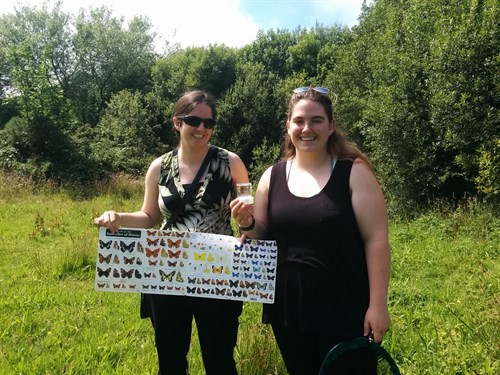Protecting wildlife one survey at a time
The Nature of Our Village project set out to massively increase how much people know about wildlife in Penparcau, a village of over 3,000 people and covering 190 hectares in West Wales. Their aim is to create a new generation of people with the skills to recognise and record the wildlife on their doorstep.
Increased public understanding about wildlife and the threats it faces is often the first step to protecting nature. Wildlife recording helps councils, governments and other bodies like Natural Resources Wales and the Wildlife Trusts to make decisions on policies, conservation measures and how they spend their budgets. This project provides evidence of the wealth of species in Penparcau, based on scientific methods, and their data has been through rigorous checks for accuracy.
It began in November 2015 as a partnership between the Penparcau Community Forum, the West Wales Biodiversity Information Centre, and the Wildlife Trust for South and West Wales. The project is run by Chloe Griffiths, an Ecologist living in Penparcau.

Since the project began in November 2015 they have engaged with over 1,000 people, run 216 sessions (surveys, walks and talks), and noted 2,505 records of species.
The project expanded in 2017, with increases in the number of species recorded and organisations and individuals engaged.
They had training in Dung Beetle identification at the Oxford University Museum of Natural History, Advanced Bee Identification from Bumblebee Conservation, and Grasshopper and Bush-cricket identification from a local naturalist. They also carried out surveys with the Wildlife Trust of South and West Wales.
Highlights from their wildlife surveys conducted include…


– Invertebrates (such as moths, butterflies, bees, and beetles):
Some particularly valuable records were the re-finding of the White Ermine and the Common Pug, both last recorded in Penparcau in 1937! The group were pleased to refind all 7 of their 2016 Bumblebee species in 2017, which are the Early, Tree, Garden, Common Carder, Red-tailed, White-tailed, and Buff-tailed species. The group carried out regular invertebrate surveys across the village and were happy to see some good numbers of Common Red Soldier Beetle (Rhagonycha fulva) (104 on 4 July), and more than 100 Garden Chafer Beetles (Phyllopertha horticola), swarming on Pen Dinas one summer morning before going to rest on the flower heads of a hay meadow at noon.
– Reptiles:
During their regular reptile surveys a second population of Common Lizards on Tanybwlch beach itself was discovered, separated from the main colony on Pen Dinas by the narrow and shallow River Ystwyth. Reptile specialists from ARC (Amphibian and Reptile Conservation) have noted that it is likely that the lizards are swimming across and are thus able to benefit from the genetic diversity of both populations, and the resources of both territories.

– Birds:
Thanks to a combination of their own bird surveys, the Ceredigion Bird Blog, the Ceredigion Bird Report 2016, and generous sharing of data from individuals, the project now has a much better idea of what bird activity there is in Penparcau. 82 species were recorded in 2017, out of a total of 91 bird species ever recorded in Penparcau.
– Mammals:
The group was delighted to find Water Vole at a location in the Aberystwyth area; a population first recorded in 2004. This is fantastic news, as these animals have suffered a massive decline of around 90%. Aberystwyth’s population is now important on a national scale as one of the few that has managed to hang on. This year the group were even lucky enough to see the animal itself coming out of a burrow, one volunteer said;
“That’s really amazing, to actually see the animal itself, I never expected that, I had a brilliant time.”

– Marine life:
A massive influx of Portuguese Man o’ War was surprisingly recorded in the seas around the UK in September – December 2017. It was possible for the first time to map their spread in almost real time around our coasts via social media.
Gudrun Limbrick, from the Beach Matters website, wrote;
“What followed was the most amazing citizen science endeavour. Through social media, more than 300 sightings were reported to me over the 12 weeks the Portuguese Men o’ War were around. These sightings have led to this, the most comprehensive mapping of PMOW we have!”
Contributing to this “live-tracking” of species via social media is one of the ways that biological recording in Penparcau, and other areas, can clearly show an immediate national impact. Groups and individuals can collaborate with the scientific community in close to real time to participate in increasingly accurate understandings of the spread of species in the UK.

What’s next?
The Nature of our Village project will continue in 2018, where the group will aim to fill as many of the gaps as possible in the picture of how their local wildlife is doing. There is a massive amount of work to do, and as the threats to nature continue to pile up, it is increasingly vital to learn about and protect what we have.
If you would like to find out more, or to come along and take part, get in touch through their facebook group or email chloe.griffiths.ecology@gmail.com

